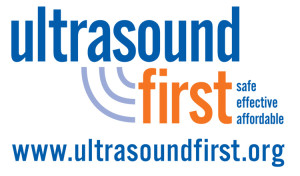Jan Greene, Staff Writer – Mint Medical Education
May 31, 2013
Earlier this year the American Institute of Ultrasound in Medicine (AIUM) launched its Ultrasound First campaign, declaring 2013 the Year of Ultrasound. Along with the Society of Ultrasound in Medical Education, AIUM is promoting the widespread use of point-of-care ultrasound in medical education and clinical practice.
It’s part of an effort to promote ultrasound as a safe, effective and affordable alternative to other imaging options.
Here’s what AIUM says in an Ultrasound First brochure:
For appropriate clinical conditions, ultrasound offers clear safety and economic advantages over radiographic exams, and yet evidence suggests that ultrasound is underutilized. Many clinicians are unaware of the range of conditions for which ultrasound first is an established guideline, and the gap only grows larger as research extends ultrasound’s diagnostic value.
Of course, there’s always going to be debate about the evidence. In the October 18, 2012 Emergency Medicine News, Mark Mosley, MD, argues that in the case of evaluating possible appendicitis in children, the use of ultrasound may actually increase the number of CT exams because of the uncertainty caused by variation in the sensitivity of ultrasound being carried out by different ultrasonographers and emergency physicians doing their own. Dr. Mosley is director of quality improvement and medical director for residency education at Wesley Emergency Center in Wichita, Kansas. He goes on to say:
[What do our readers think about the debate? You can comment in the blog post on this topic.]If you order CT scans on all pediatric ultrasounds that are nondiagnostic or even true negative scans where the appendix was visualized with good compressibility, you will still be ordering a lot of CT scans but at a higher cost and a much longer time in the department. The ultrasound followed by CT is a huge chunk of time that is bound to be a patient dissatisfier in an age where length of stay may become a CMS metric of quality.
AIUM is regularly publishing scientific papers on various uses of ultrasound in medicine. Here are links to some of them:
Sonography in Postmenopausal Bleeding – Steven R. Goldstein, MD
Think Ultrasound When Evaluating for Pneumothorax – Vicki E. Noble, MD
Sonography Should Be the First Imaging Examination Done to Evaluate Patients With Suspected Endometriosis – Beryl R. Benacerraf, MD, and Yvette Groszmann, MD
Sonography of Adenomyosis – Khaled Sakhel, MD, and Alfred Abuhamad, MD
Lung Ultrasound in Evaluation of Pneumonia – Michael Blaivas, MD
Ultrasound-Guided Interscalene Blocks – Andrew Gorlin, MD, and Lisa Warren, MD
Sonography for Surveillance of Patients With Crohn Disease – Kerri L. Novak, MSc, MD, FRCPC, and Stephanie R. Wilson, MD, FRCPC
Sonography as the First Line of Evaluation in Children With Suspected Acute Appendicitis – Leann E. Linam, MD, and Martha Munden, MD
Shoulder Sonography: Why We Do It – Sharlene A. Teefey, MD
Sonographically Guided Enema for Intussusception Reduction: A Safer Alternative to Fluoroscopy – Thomas Ray S. Sanchez, MD, Aaron Potnick, MD, Joy L. Graf, MD, Lisa P. Abramson, MD and Chirag V. Patel, MD
Sonography First for Subcutaneous Abscess and Cellulitis Evaluation – Srikar Adhikari, MD, RDMS, and Michael Blaivas, MD
Sonography in the Treatment of Calcific Tendinitis of the Rotator Cuff – Gregory R. Saboeiro
